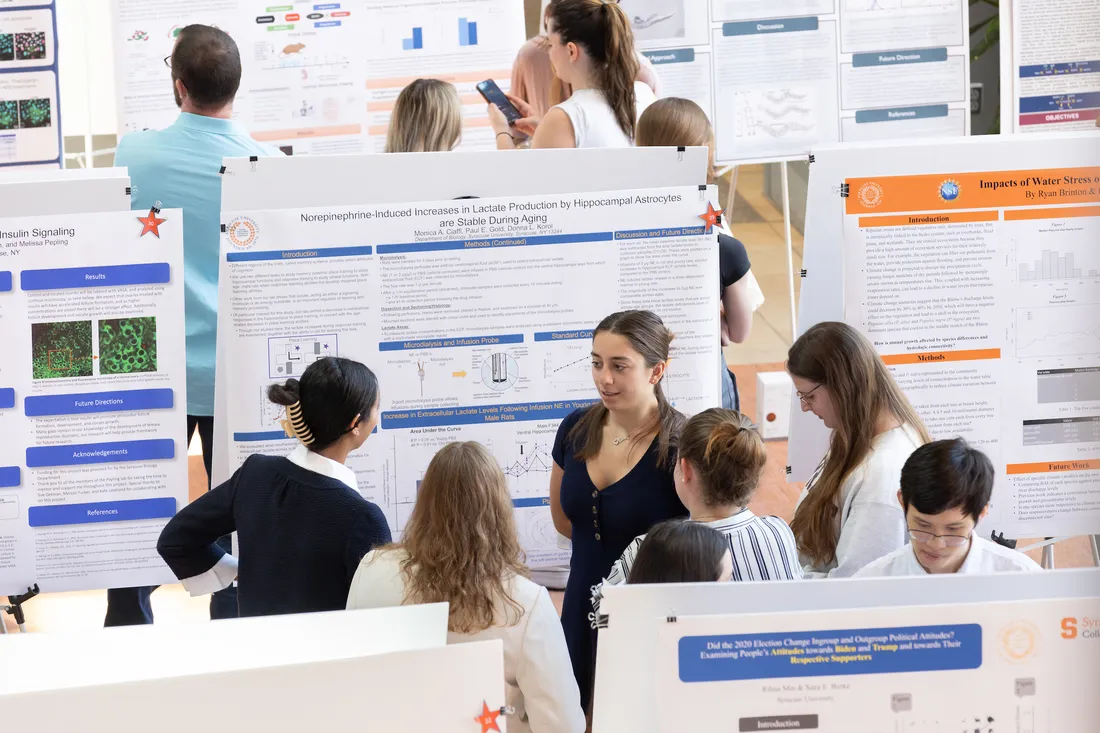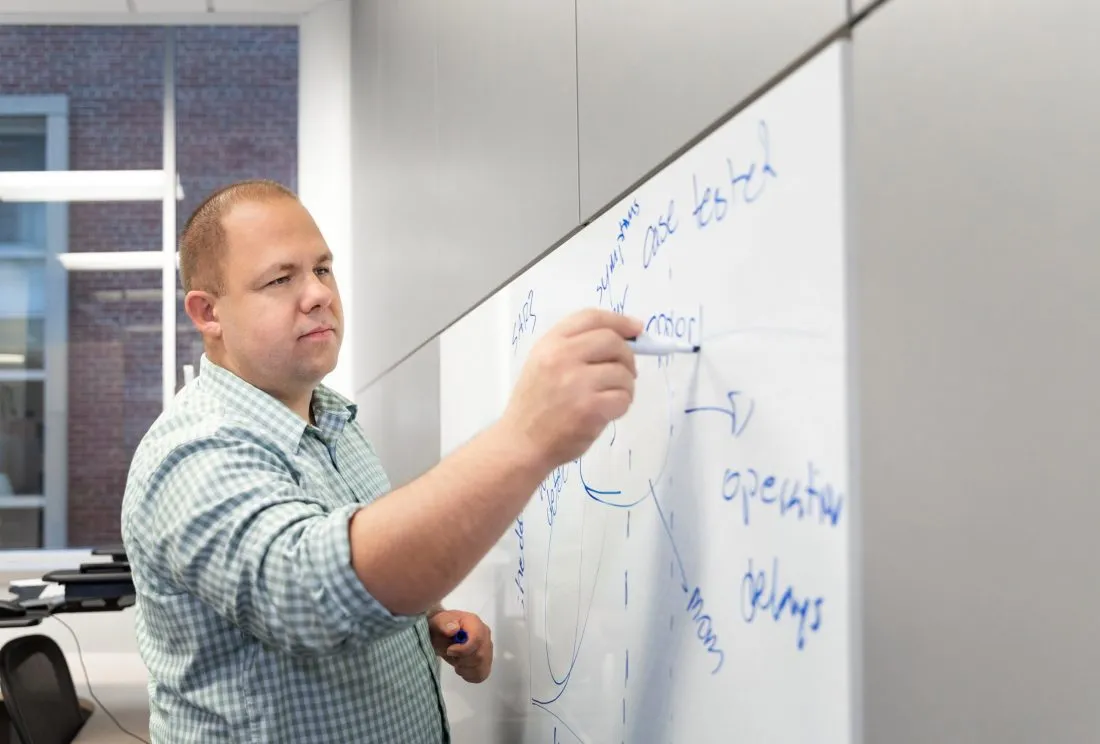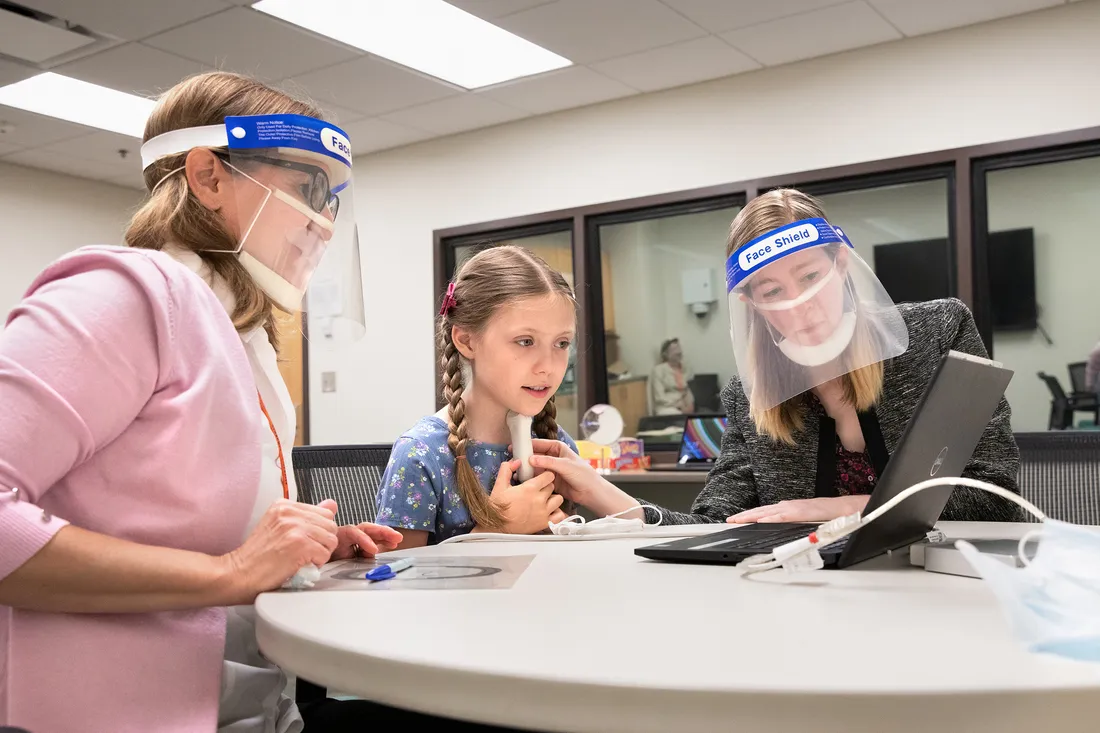
A young client uses ultrasound technology to visualize her tongue’s shape and movement in the Gebbie Clinic.
The first time Urooj Qazi G’21 set foot in the Gebbie Speech, Language and Hearing Clinic was on the first day of classes in fall 2017. By lunchtime, she had clocked the first of her 2,850 clinical hours as a Doctor of Audiology student at Syracuse University. “I didn’t attend any academic classes until that evening,” recalls Qazi, a newly minted audiologist at The University of Texas Medical Branch at Galveston. “At Syracuse, you gain clinical experience literally on day one. Where else can you do that?”
The University’s hands-on ethos was indispensable to Qazi, whose four-year program culminated with a 12-month clinical practicum at Galveston. Among her responsibilities was administering diagnostic and treatment services for clients of all ages and backgrounds—“putting theory into practice,” she says.
The Texas native is a proud alumna of Syracuse’s audiology program, which, along with curricula in speech-language pathology (SLP), makes up the Department of Communication Sciences and Disorders. Based in the College of Arts and Sciences, the 73-year-old department is a Syracuse success story, boasting a 99% employment rate among graduates. At the heart of the department is the Gebbie Clinic, a nationally renowned educational, research and clinical facility.
I started seeing Gebbie clients when I was a junior. Accessing technologies like telepractice and clinical simulations allows me to treat and diagnose complex speech problems in new ways.
Gabriella Giacovelli ’19, G’22
Building Excellence
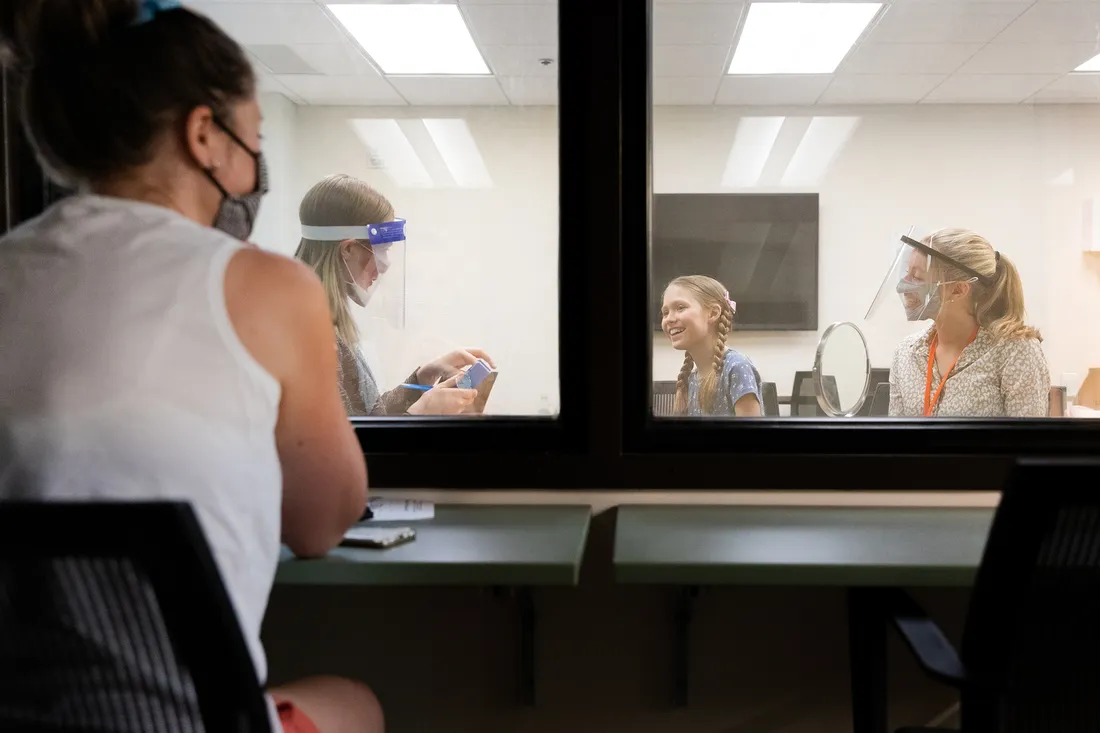
Clinical students get hands-on training in the Gebbie Clinic's many speech-therapy rooms.
The Gebbie Clinic was a fixture on Marshall Street until 2014, when the communication sciences and disorders department relocated to South Campus. Its newly renovated space provides state-of-the-art speech and hearing care to the local community and high-tech, hands-on training for clinical students. Housing academic and clinical faculty under one roof enables professors to translate research findings into clinical practice, explains Professor Karen Doherty. “The clinic is a physical expression of our commitment to speech, language and hearing wellness,” she says, noting Gebbie’s connection to the eponymous foundation that helped launch it in 1972.
Serving more than 3,900 clients a year, the Gebbie Clinic boasts dozens of individual and group speech-therapy rooms. Many of them contain diagnostic and treatment equipment, like Lee Silverman Voice Treatment software and ultrasound technology, benefiting individuals with Parkinson’s disease and other neurological conditions. Gebbie also is home to a clinical observation recording system, sound booths for hearing testing, a hearing aid fitting room, an auditory brainstem response testing suite and a new vestibular testing room.
Fresh from a seven-year run as department chair, Doherty is excited to see her successor, Professor Kathy Vander Werff, pen a new chapter in its history. “She will provide the necessary leadership for growing our research, clinical training and service to the community,” Doherty says. “The department is in good hands with Kathy as chair and with professors Joseph Pellegrino and Colleen Gargan as directors of the hearing clinic and speech-language clinic, respectively.”
Responding to Crisis
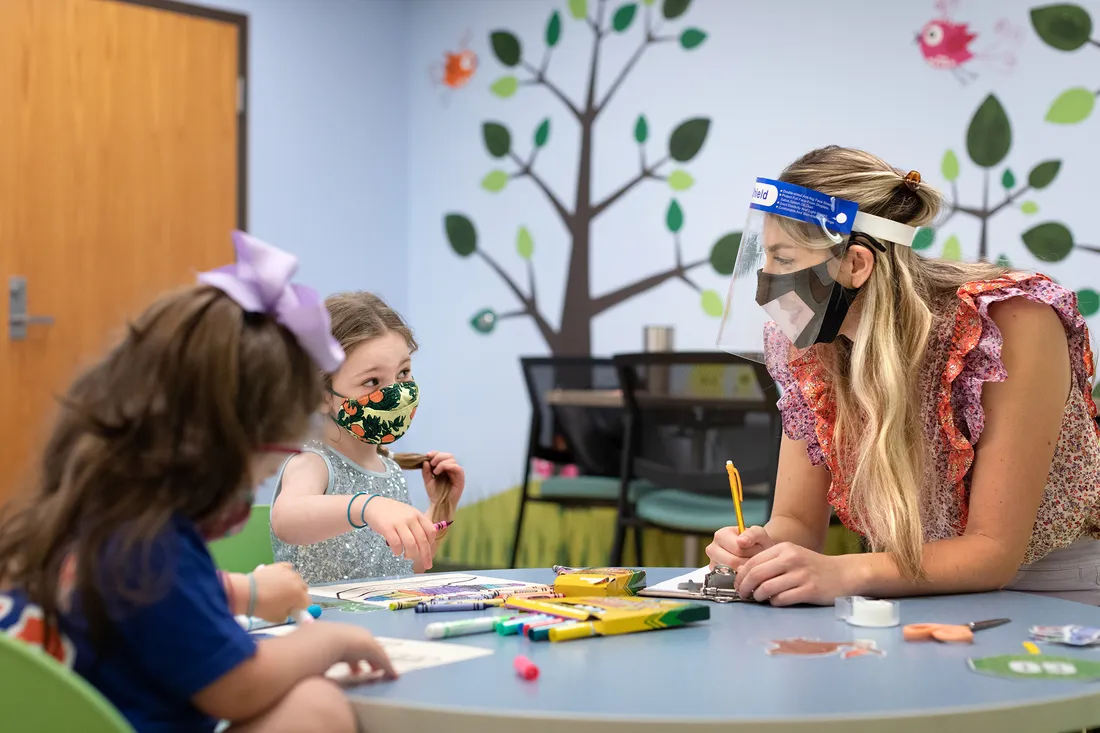
The Gebbie Clinic serves more than 3,900 clients a year, including children and adults.
Seated behind her desk in the department’s 14,000-square-foot facility, Doherty recalls the initial impact of COVID-19—how she and her colleagues swiftly moved to online teaching and began offering telehealth services and curbside hearing aid support to the public. “The Gebbie Clinic provides essential services as defined by New York State,” she says. “I credit Mike Haynie [vice chancellor for strategic initiatives and innovation] and Karin Ruhlandt [dean of Arts and Sciences] for allowing us to reopen in the spring of 2020, when most of campus was shut down.” Doherty also commends Pellegrino and Gargan for implementing COVID safety protocols in the clinic, like the wearing of masks, gloves, face shields and clinic scrubs, which has become the norm among students and faculty.
The clinic is a physical expression of our commitment to speech, language and hearing wellness.
Professor Karen Doherty
Audiology student Brena Brennan G’22 was training at the Syracuse VA Medical Center when COVID-19 hit. Like most of her doctoral peers, she put everything on hold while state and national agencies sorted out a strategic response. Brennan noticed that people living with hearing loss acutely felt the weight of the pandemic. The Hearing Loss Association of America confirmed her observation, finding 95% of the hearing-impaired community believed that wearing masks hindered interpersonal communication. Many of these people also experienced mental health issues, like anxiety, confusion and isolation.
“The pandemic raises all sorts of accessibility issues,” says Brennan, who is completing her fourth-year externship at SUNY Downstate Health Sciences University in Brooklyn. “It’s impossible to lip-read someone wearing a mask, just as it’s hard to talk to a person 6 feet away from you. People living with hearing loss recognize the difference between being heard and being understood.”
During her externship, Brennan was exposed to various treatments and services, including neonatal screening, auditory brainstem response testing, auditory processing disorder treatment and tinnitus retraining therapy. She also became fluent in the hearing aid delivery process. Because hearing loss has become so pervasive (like the technologies used to treat it), its associated stigma is fading. “Most people can’t tell between earbuds and AirPods,” says Brennan, the 2019 winner of the University’s Louis M. DiCarlo Scholarship Award for clinical excellence. She praises the clinical audiology faculty, led by Pellegrino, for fostering a safe, nurturing environment. “Our clients recognize that what might take 20 minutes at another clinic can take upwards of an hour at ours,” Pellegrino says. “Clients appreciate the investment in time because as they get to know our students, they realize they’re getting state-of-the-art care.”
Giving Voice to Hope
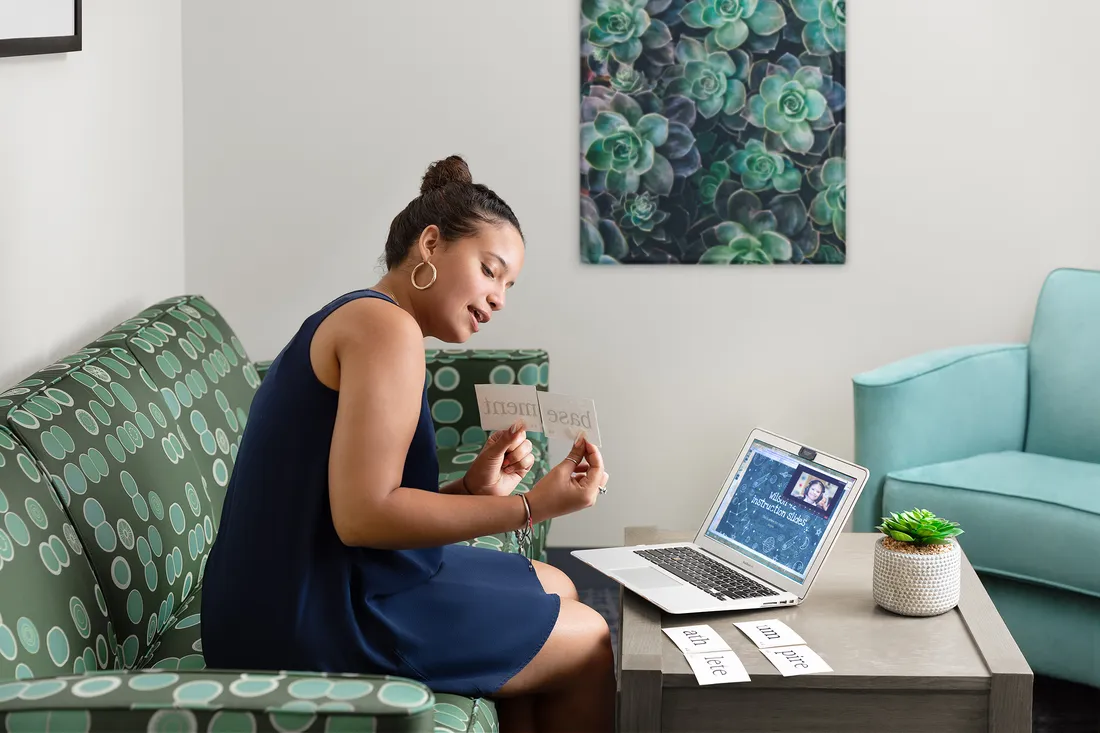
The pandemic has forced students to embrace alternative service delivery models, like telepractice and clinical simulation.
Nicole Awad G’21 has worked with hundreds of SLP clients, but she encountered some of the most memorable during her first semester at the Gebbie Clinic. Like the 9-year-old boy who struggled with social communication because of an autism diagnosis. Or the European teaching assistant seeking accent addition therapy so that his students could better understand him. “My patients have taught me a lot,” says Awad, a clinical fellow at Van Duyn Center for Rehabilitation and Nursing in Syracuse.
Since graduating in May, she has been in the throes of a nine-month clinical fellowship as part of her SLP licensure. At Van Duyn, Awad serves mostly adult and geriatric clients with swallowing problems. “The medical term for a swallowing disorder is ‘dysphagia,’ and I am fascinated by this area of clinical practice,” she says. “Some SLPs are scared to work with this population because the stakes are high. Dysphagia can lead to aspiration pneumonia, caused by food entering the lungs. It can be deadly.”
Awad became attuned to the neurology of swallowing disorders (such as those caused by stroke, aphasia and traumatic brain injury) during a recent externship at Guthrie Cortland Medical Center south of Syracuse. The experience was a fitting conclusion to her two-year master’s program, where she racked up some 400 clinical hours on and off campus. “You’d be amazed at what a complex process swallowing is,” says Awad, noting the involvement of some 50 pairs of muscles in the neck and throat. “At Gebbie and then Guthrie, I treated patients for whom swallowing had gotten harder, especially as they grew older.”
Integrating Technology with Expert Insight
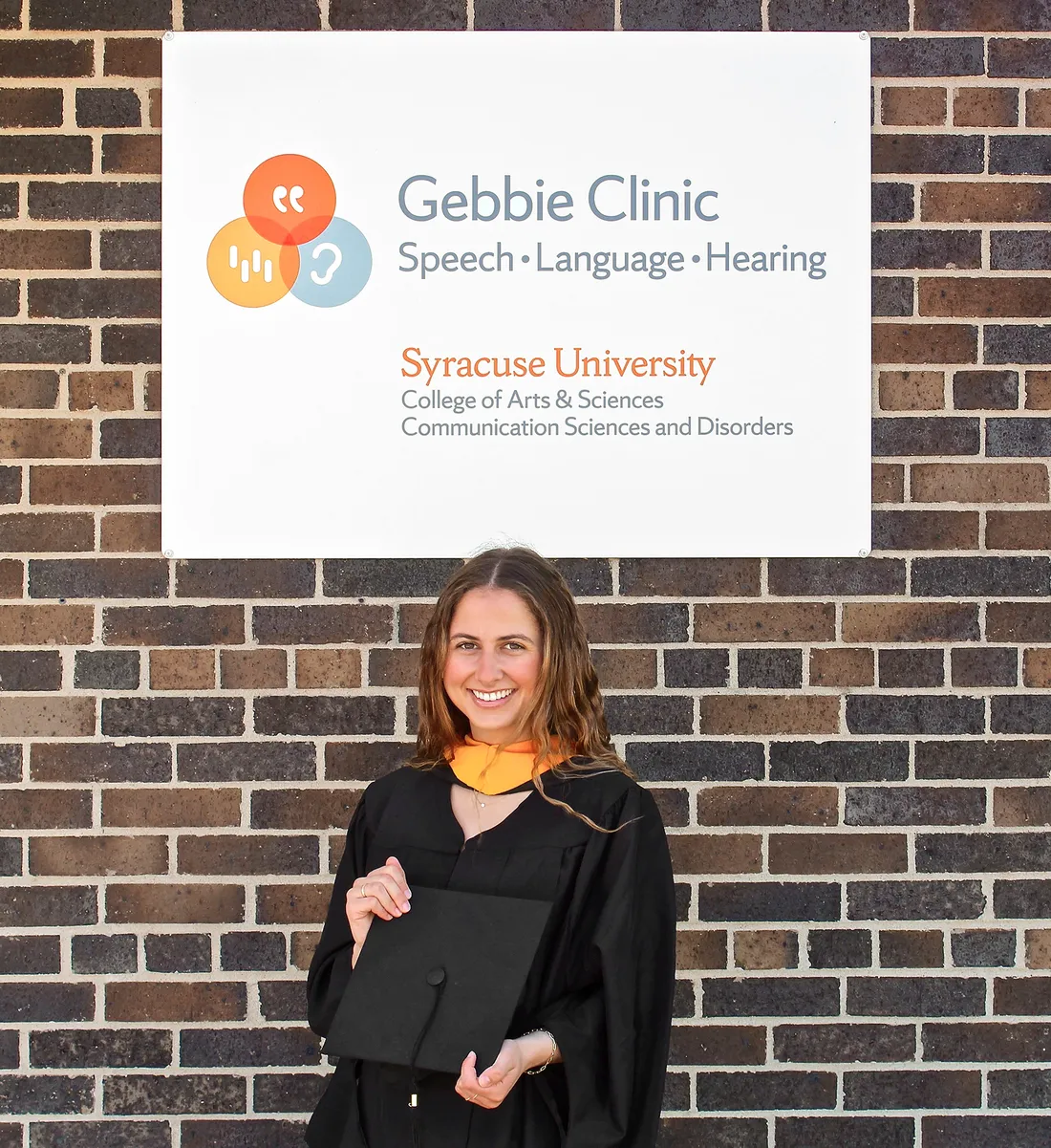
Jaclyn Bedder G’21 is finishing a speech-language externship in Toronto.
The pandemic has forced students like Awad to consider alternative service delivery models and practicum experiences. “Whether engaging in telepractice or clinical simulation [through a technology called Simucase], students learn to use technology strategically to deliver SLP services and to enhance their clinical competencies,” Gargan says. The result is a hybrid training model, providing in-person, telepractice and Simucase experience, she adds.
Master’s student Gabriella Giacovelli ’19, G’22 embodies this integrated approach. “I started seeing Gebbie clients when I was a junior,” says the Syracuse native, who earned a bachelor’s degree in communication sciences and disorders. “Accessing technologies like telepractice and clinical simulations allows me to treat and diagnose complex speech problems in new ways.”
Case in point: She uses ultrasound to visualize the tongue’s shape and movement—a treatment pioneered by Associate Professor Jonathan Preston G’02, G’08, with support from the National Institutes of Health. “Gebbie is the only clinic in Central New York offering ultrasound therapy for speech sound disorders,” says Giacovelli, who uses specialized apps and software to analyze voice samples from clients. “The expectations are high, because I’m not just observing clients; I’m treating them.” Such rigor has transformed the clinic—and the department in general—into an SLP powerhouse, renowned for its research into articulation, fluency, voice and resonance, language, cognition, hearing, swallowing, social communication, and communication modalities.
Technology is here to stay and improve lives. I should know because I saw a speech therapist as a child. The experience has remained with me and, with the advent of technology, inspired me to make a difference for others.
Jaclyn Bedder G’21
Jaclyn Bedder G’21, who graduates in December, attests to the ever-evolving nature of clinical training. The Ontario native hasn’t been back to campus since March 2020, due to the pandemic. She says the department’s embrace of new, innovative technologies has kept her academic dreams alive while shaping her understanding of clinical practice. “Technology is here to stay and improve lives,” says Bedder, who is wrapping up a clinical placement in Toronto. “I should know because I saw a speech therapist as a child. The experience has remained with me and, with the advent of technology, inspired me to make a difference for others.”

